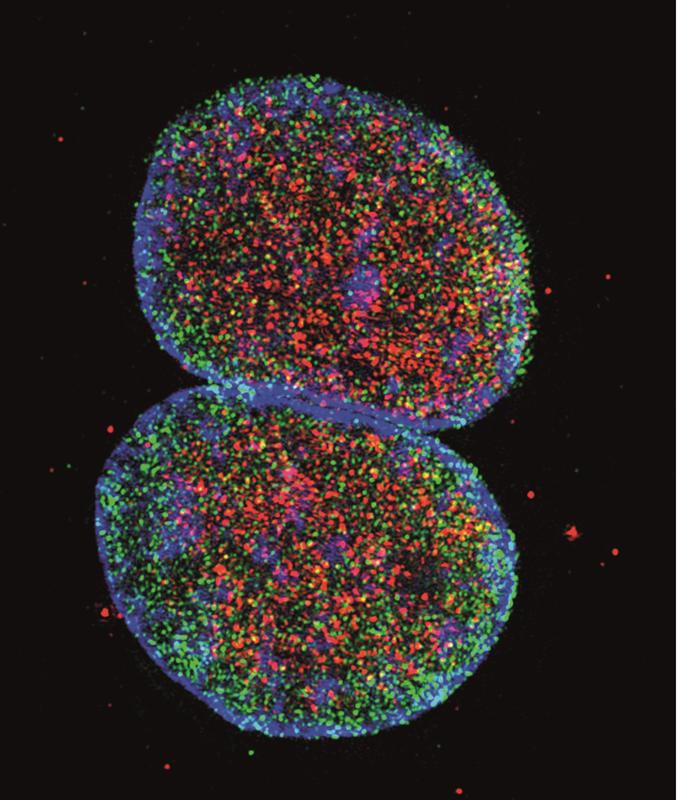Fueling Replication – how herpes viruses get to cellular DNA building blocks

In human immune cells, the DNA in the cell nucleus (blue), viral proteins (green) and the phosphorylated, i.e. inactivated form of SAMHD1 (red) were stained and examined microscopically. Ramona Businger and Michael Schindler, University Hospital Tübingen
In detail, the virus blocks the cellular enzyme SAMHD1, which regulates the provision of nucleotides through its activity. Normally, this protects the cell from infectious pathogens and ensures proper genome replication and repair, which also prevents the development of tumors. Thus, the knowledge gained in these studies is an important basis for novel therapies against DNA viruses and cancer.
The researchers were able to show that both human and murine CMV code for a protein, namely the viral kinase pUL97 or M97, which modifies SAMHD1 and thus inactivates it.
“In infected mice that were genetically manipulated in such a way that they did not express SAMHD1, we found a strongly increased CMV replication,” explains Janina Deutschmann, PhD student in the laboratory of Prof. Gramberg and first author of the mouse study.
“The effect was even more pronounced when the viruses no longer encoded the kinase M97 to inactivate SAMHD1,” she continues. Dr. Ramona Businger, first author of the second study in Prof. Schindler's laboratory, also investigated the effects in the human system. “A drastic increase in SAMHD1 phosphorylation was observed in primary human immune cells after CMV infection. We were able to directly relate this to the activity of the viral kinase pUL97,” explains Dr. Businger.
However, there are also differences between humans and mice. While murine CMV seems to switch off SAMHD1 only by its kinase, its human counterpart also targets the production of SAMHD1. This shows how important this factor is for virus replication.
It is also known that other viruses, and probably also tumor cells, have to inactivate SAMHD1 as well in order to multiply efficiently. Based on these findings, the researchers now hope to jointly develop novel approaches to fight viral infectious agents and tumor diseases.
Prof. Dr. Michael Schindler
michael.schindler@med.uni-tuebingen.de
+49 7071 29-87459
Businger et al., Human cytomegalovirus overcomes SAMHD1 restriction in macrophages via pUL97, www.nature.com/articles/s41564-019-0557-8
DOI: 10.1038/s41564-019-0557-8
Deutschmann et al., A viral kinase counteracts in vivo restriction of murine cytomegalovirus by SAMHD1, www.nature.com/articles/s41564-019-0529-z
DOI: 10.1038/s41564-019-0529-z
Media Contact
More Information:
http://www.medizin.uni-tuebingen.de/All latest news from the category: Health and Medicine
This subject area encompasses research and studies in the field of human medicine.
Among the wide-ranging list of topics covered here are anesthesiology, anatomy, surgery, human genetics, hygiene and environmental medicine, internal medicine, neurology, pharmacology, physiology, urology and dental medicine.
Newest articles

A new puzzle piece for string theory research
Dr. Ksenia Fedosova from the Cluster of Excellence Mathematics Münster, along with an international research team, has proven a conjecture in string theory that physicists had proposed regarding certain equations….

Climate change can cause stress in herring larvae
The occurrence of multiple stressors undermines the acclimatisation strategies of juvenile herring: If larvae are exposed to several stress factors at the same time, their ability to respond to these…

Making high-yielding rice affordable and sustainable
Plant biologists show how two genes work together to trigger embryo formation in rice. Rice is a staple food crop for more than half the world’s population, but most farmers…



